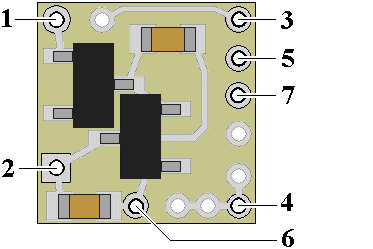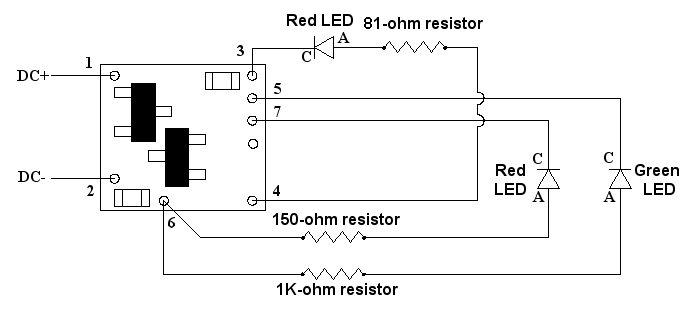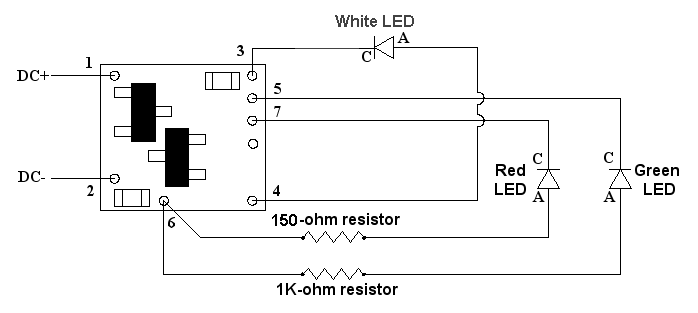Best viewed using:
Internet Explorer
or
Mozilla Firefox
N8062A & N8062B Navigation Simulator Effect and Installation
Description of Lighting Effects
This simulator is programmed to run dual red LED beacons (vary in intensities to simulate rotational effect), and 1 red LED configured as port or left-side wingtip strobe, and 1 green LED for starboard, or right-side wingtip strobe. Timing of the beacons are simultaneous and approximately once per second. After every second beacon cycle the strobes pulse for a short 25ms burst. This mimics many tail beacons and wingtip strobes seen on many aircraft.
Connecting the N8062A or N8062B
Installing the N8062A or N8062B is very straightforward. Its tiny size and thin construction will allow it to be placed nearly anywhere in any scale model. Because the module has circuitry on both sides, care must be taken to be sure that the components or wires soldered will not make contact with any metal object causing a short circuit.
The N8062A can be powered by battery or any well-filtered and regulated DC power source with an output of 6-18VDC.
Included with the module are two 6" lengths of #32 insulated wire. If necessary, these can be used for power input wires.
Solder point #1 is the + DC power connection as shown in Fig. 1.

Figure 1
Important note: A low-wattage
iron with a pointed tip should be used for connection of wires. Too much heat or
solder can easily damage the wires or module and void the warranty. Also, all
connecting wires should be pre-tinned before soldering them to the module. This
will make connection quick and easy and ensure excessive heat is not applied to
the solder points. Solder point #2 is the -DC (or
ground) power connection. Connecting N8062A LEDs Included with this
module are 3 small packs of 1/8-watt surface-mount resistors. Upon close
examination of the resistors (viewing them through the clear film covering
on each pack), note each resistor has a series of number or number and
letters printed on them. These correspond to the resistance value in ohms,
of the resistors: 80R6 = 81 ohms 1500 = 150 ohms 1001 = 1000 or 1K ohms When connecting the LEDs, proper
polarity must be observed. LEDs are polarity sensitive and will not function
if connected backwards. The N8062A is configured to allow connection of two 20 ma
red LEDs, wired in series with device voltages of 1.75-2.0 volts DC (Ngineering's
Micro and Nano red LEDs, as well as many red LEDs available).
These LEDs will use the on-board
current limiting resistor so they can be wired directly. See Fig. 2 below.
Using wire appropriate for the size
of the LEDs and their placement in the model, connect the two red LEDs in series
with each other (daisy-chained anode to cathode) to the simulator module as shown
below. Connect the cathode
wire
(the � connection) of the first LED to point 3 on the module and
connect the anode wire of the second LED
(the +) to solder point 4.
Figure 2
Note: If only one red beacon is desired instead of two,
connect one of the supplied 81-ohm resistors in series with the one
red beacon LED to be wired. This resistor will balance the current load as a
substitute for the second LED. See Fig. 3 below for details.
Figure 3 

The next two (2) LED connections will be for the wingtip strobe lights. Each LED must be wired with an external resistor in series to limit the current flow through the LED. These two LEDs are different in color and have different device voltages. The red LED has a device voltage of 1.75-2.0 volts DC (Ngineering's Micro and Nano red LEDs, as well as many red LEDs available). The green LED is a high-intensity Signal Green LED with a device voltage of 3.3-volts DC (such as Ngineering's Nano Signal Green). As a result, each must use a different valued resistor. Included with this module are two additional 1/8-watt surface-mount resistors (we've included a spare with each). These resistors are tiny for easy placement and have pre-tinned tabs so soldering is easy. The green LED's cathode is to be wired to solder point 5 on the module. Select a 1K-ohm resistor and wire it in series between this LED's anode and point 6. The red LED's cathode is to be wired to solder point 7 on the module. Select a 150-ohm resistor and wire it in series between this LED's anode and point 6. See Fig. 2 or 3 for details of these connections
Connecting N8062B LEDs
Included with this module are 2 small packs of 1/8-watt surface-mount resistors. Upon close examination of the resistors (viewing them through the clear film covering on each pack), note each resistor has a series of number or number and letters printed on them. These correspond to the resistance value in ohms, of the resistors:
1500 = 150 ohms
1001 = 1000 or 1K ohms
When connecting the LEDs, proper polarity must be observed. LEDs are polarity sensitive and will not function if connected backwards. The N8062B is configured to allow connection of one 20ma white LED, with a device voltage of 3.0-3.3 volts DC (Ngineering's Micro, Nano & 3mm white LEDs, as well as many white LEDs available). This LED will use the on-board current limiting resistor so they can be wired directly. See Fig. 4 below.
Using wire appropriate for the size of the LED and its placement in the model, connect the white LED to the simulator module as shown below. Connect the cathode wire (the - connection) to point 3 on the module and connect the anode wire (the +) to solder point 4.

Figure 4
The next two (2) LED connections will be for the wingtip strobe lights. Each LED must be wired with an external resistor in series to limit the current flow through the LED. These two LEDs are different in color and have different device voltages. The red LED has a device voltage of 1.75-2.0 volts DC (Ngineering's Micro and Nano red LEDs, as well as many red LEDs available). The green LED is a high-intensity Signal Green LED with a device voltage of 3.3-volts DC (such as Ngineering's Nano Signal Green). As a result, each must use a different valued resistor. Included with this module are two additional 1/8-watt surface-mount resistors (we've included a spare with each). These resistors are tiny for easy placement and have pre-tinned tabs so soldering is easy. The green LED's cathode is to be wired to solder point 5 on the module. Select a 1K-ohm resistor and wire it in series between this LED's anode and point 6. The red LED's cathode is to be wired to solder point 7 on the module. Select a 150-ohm resistor and wire it in series between this LED's anode and point 6. See Fig. 4 above for details of these connections
Once again, be sure to use a low-wattage soldering iron when connecting wires to the module. Our N40M2 12-watt Iron with either the N408I (iron clad) Needle Tip, or the N408X (bare copper) Needle Tip would be an excellent choice for this operation.
This completes connection of the N8062A and N8062B modules. It is recommended that a thorough re-inspection of all connections and module placement be performed prior to applying power to your model. We hope you enjoy the added realism our module provides.
� 2020 Ngineering





















